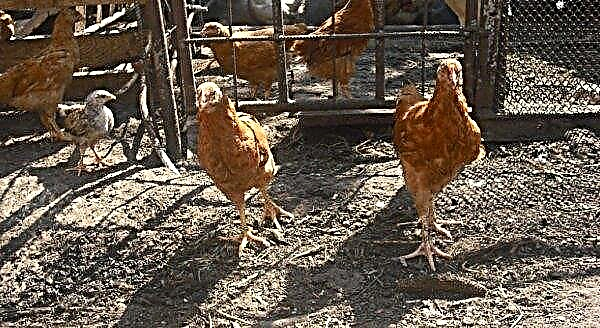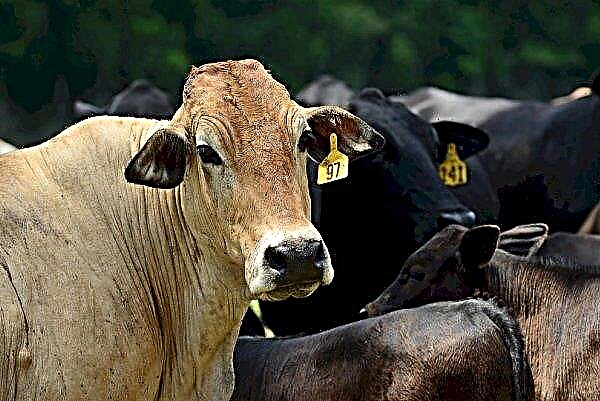Cucumbers are one of the three most popular vegetables in our country and are often found both in industrial greenhouses and in private areas of summer residents. That is why this culture is so often subjected to selection, and new varieties have numerous positive characteristics. New cucumber hybrids include the Bettina variety, which will be discussed in our material.
History of Variety Breeding
Bettina variety was bred relatively recently - in 2007, thanks to the research work of the Dutch selection company Nunhems. Initially, the main characteristics that were sought when growing a new hybrid were high yield under various climatic conditions, including unfavorable.
As a result, the Bettina variety not only achieved its goals, but also became a real champion in terms of the beginning of fruiting. Already in 2010, this hybrid was included in the unified state register of Russia in all regions.
Bettina Variety Description
Bettin cucumbers are early ripening gherkins such as gherkins. This variety is appreciated for its suitability for growing both in open ground and in greenhouse conditions, and on balconies or window sills. A distinctive feature of Bettina is his parthenocarpy, i.e., the absence of the need for pollination. This crop shows the best harvest results in a mild climate, but it can easily tolerate various temperature fluctuations.
This crop shows the best harvest results in a mild climate, but it can easily tolerate various temperature fluctuations.
Did you know? The ancient Egyptians put cucumbers in the tombs of the pharaohs along with other valuable things.
Bushes
Bettin cucumbers belong to indeterminate varieties (the main ovaries are formed on the central stem) and are distinguished by branchy weaving. The leaves have a light green color with an average size of the plates, which, however, increase in greenhouse growing conditions.
In each leaf sinus, 1-3 ovaries (nodes) are formed, which, in turn, can produce 2–4 green leaves. The female type of flowering prevails ..
Fruit
The fruit has a cylindrical shape and a length of about 10–13 cm. The mass of cucumbers reaches 70 g. The pulp is juicy and crunchy, without bitterness and cavities - these properties are not lost even when preserved. Bettina belongs to hybrid varieties, which means that the seeds in such vegetables either have an underdeveloped structure or are completely absent.
The surface of the fruit has small tubercles and spikes. The color of cucumbers is highly dependent on the frequency of irrigation and the quality of the soil. Under normal conditions, the peel has a rich dark green color. With a high content of natural acids in the soil, yellow spots or small streaks may appear on the surface of the cucumbers, which is not a deviation from the norm.
Productivity
Bettina belongs to the early ripe varieties, so the first harvest can be carried out already on the 40th day. As an optimal scheme, one collection is carried out in 2-3 days. The commodity yield of cucumbers of this variety can reach 5 kg with 1 m². Basically, the amount of yield depends on proper care and the creation of the most favorable conditions for the growth and development of this plant.
The commodity yield of cucumbers of this variety can reach 5 kg with 1 m². Basically, the amount of yield depends on proper care and the creation of the most favorable conditions for the growth and development of this plant.
Pros and cons of the variety
- Bettina variety has many advantages, among which are noted:
- high productivity;
- the possibility of harvesting twice in 1 season, due to the short ripening period;
- unpretentiousness to the rules of care, climatic and weather conditions, temperature conditions, etc .;
- lack of need for a large amount of lighting.
- The disadvantages of this variety are only 2:
- rather high price category of seeds;
- due to the fact that Bettina is a hybrid variety, the collection of planting material is not possible on its own
Planting and growing cucumbers
In general, planting and caring for Bettina is no different from ordinary cucumbers. Depending on the region, the seeds of this variety can be sown directly into the ground (typical for the southern regions) or grown in seedlings (areas with a cold or temperate climate).
Seedling method
Seeds for seedlings are sown in early May, 2-3 weeks before the intended planting in the ground.
Important! Seedling method of growing accelerates fruiting by 1.5–2 weeks.
The soil is prepared in advance - they buy the finished substrate or prepare it on their own (peat, sawdust, turf land and humus in equal parts). Before sowing, all seeds go through several stages of preparation, which increase the likelihood of obtaining strong and healthy seedlings, and therefore the quality of the crop:
Before sowing, all seeds go through several stages of preparation, which increase the likelihood of obtaining strong and healthy seedlings, and therefore the quality of the crop:
- Seed rejection - soaking planting material in saline solution (35 g of salt per 1 liter of water) for 10-15 minutes and the removal of emerging empty seeds.
- Disinfection - soaking seeds for 20-24 hours in a weak solution of potassium permanganate to get rid of possible viral, fungal and bacterial diseases.
- Germination - a procedure that is carried out to accelerate the emergence of seedlings and consists in placing the seeds in a container with moistened tissue until the first shoots appear (about 10 days).
- Quenching - placing seeds in a variable temperature regime.
After sowing seeds, the prepared container is covered with a plastic film or glass, until the first sprouts appear. The temperature regime at this time should be maintained at +20 ... + 23 ° С during the day and +16 ... + 19 ° С at night. Watering is carried out 1 time per day. Seedlings also need a lot of natural light, the lack of which will require additional lighting with fluorescent lamps.
Important! Temperature above +23°C pampers seedlings, which subsequently negatively affects the overall growth and development of the plant.
For the entire period of seedling growth, at least 2 top dressings will be required, which are applied with morning watering under the root of the plant:
- First time fertilizer is applied 2 weeks after the appearance of sprouts. In this case, either ready-made fertilizers or a urea solution in the ratio of 1 tsp are used. per 1 liter of water with the calculation of 1 glass per 1 sprout.
- Second time top dressing is carried out when a second leaf appears on the stem of the sprout. In this case, use a solution of 1 teaspoon of wood ash and nitrophosphate dissolved in 3 liters of water.
 Planting seedlings is usually carried out in early June at an optimum air temperature of +20 ... + 25 ° C. As the soil for planting, loose, drained soil is used, which must be warmed up to a temperature of at least + 15 ° С. To get the best result, it is best to use the area where crops such as potatoes, tomatoes, peas or corn were grown last year.
Planting seedlings is usually carried out in early June at an optimum air temperature of +20 ... + 25 ° C. As the soil for planting, loose, drained soil is used, which must be warmed up to a temperature of at least + 15 ° С. To get the best result, it is best to use the area where crops such as potatoes, tomatoes, peas or corn were grown last year.In a reckless way
When performing direct sowing in open ground, wells are preliminarily prepared that are located at a distance of 40–45 cm from each other and about 40 cm between rows. Humus and wood ash are added to each well. The depth to which planting material is lowered is 1.5–2 cm.
Cucumber care after planting
After planting cucumbers in the soil, the rules for caring for them are greatly simplified. However, there are some nuances that should be considered to obtain a large number of rich crops.
Bush formation
In open soil conditions, Bettina shrubs do not need serious adjustment of the lashes. In this case, the central stem, on which the green leaves form, remains untouched, and only a few lower shoots undergo the pruning procedure.
When growing cucumbers of this variety in greenhouse conditions, an important condition for the proper development of the bush is the process of trimming and garter lashes. The main stem needs to be stopped when reaching the top of the trellis.
Fertilizing and watering
When watering this variety of cucumbers, you should adhere to the middle ground - Bettina loves abundant moisture, but excessive watering can cause fungal diseases. As an optimal scheme, watering every other day in the evening by sprinkling (using a watering can or a special irrigation system) is considered.
During the period of fruit development, the number of irrigations can double, since a lack of moisture at this time can provoke the bitterness of the pulp of cucumbers. For watering, it is recommended to use water at a temperature of at least + 18 ° C.
Fertilize cucumbers during their flowering period. Cow or chicken droppings, as well as mineral fertilizers, such as urea or superphosphates, are used as top dressing.
Soil care
Permanent care is necessary not only for cultivated crops, but also for the soil in which they grow. After all, it is she who carries the necessary amount of moisture, nutrients and oxygen for healthy growth and development of the root system, and hence the whole plant. Among the basic rules for the care of soil beds are distinguished:
Among the basic rules for the care of soil beds are distinguished:
- Loosening - a process that avoids the formation of crust on the surface of the earth and increase the amount of oxygen supplied to enrich the rhizome. When loosening, the lashes are carefully shifted to the side, and then returned to their place.
- Weeding - The process of removing weed grass with roots that absorb moisture and nutrients from the soil, thereby inhibiting the growth and development of cucumbers.
- Mulching - a procedure that reliably protects the soil from temperature changes, reduces the loss of moisture in the soil and increases the yield several times. As a soil cover, improvised means are used, such as straw, peat, sawdust, sometimes synthetic coatings, etc.
Disease prevention
Among the most common diseases of cucumber varieties, which can lead to loss of crop and even death of plants, are gray rot, powdery mildew and bacteriosis. Bettina F1 has innate immunity that can recognize and overcome these diseases.
However, even with such characteristics, cucumbers undergo a certain prophylaxis, in which the beds are treated with organic or mineral solutions:
- To prevent powdery mildew, use a mixture of milk, iodine and soap, which is applied to the foliage.
- To prevent the appearance of gray rot in the water for irrigation add a small amount of soda.
- As a prophylaxis of bacteriosis, the bushes are treated with Trichopolum solution (2 tablets per 1 liter of water).

Harvesting and storage features
Harvesting cucumbers of this variety is carried out every other day during the period of maximum fruiting. For conservation, collection is carried out more often - 2 times a day, in the morning and evening hours. If cucumbers require long-term storage, the fruits are cut with scissors, leaving a small shoot of the stem.
Did you know? In Iran, cucumbers are considered fruits, so they are served on the table as a dessert.
Before placing the cucumbers in the refrigerator, the fruits are left for some time in the fresh air, in a shaded place.
Bettina variety has been well-deserved for many years. Due to its unpretentiousness in care, high yield and record-breaking early dates for the first fruits, this variety is often found both in industrial greenhouses and in private gardens, and on window sills at home.












